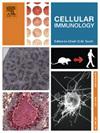Transfer of bone marrow niche-residential regulatory T cells ameliorates experimental colitis
IF 2.9
4区 医学
Q2 CELL BIOLOGY
引用次数: 0
Abstract
Background
Adoptive transfer of regulatory T cells (Tregs) has been proposed as a next-generation treatment approach for the treatment of various inflammatory or autoimmune disorders(Amini et al., 2022; Bluestone et al., 2023, 2015; Dall'Era et al., 2019; Chandran et al., 2017; Laukova and Glatman Zaretsky, 2023; Voskens et al., 2023; Canavan et al., 20161–8), inclusive of inflammatory bowel diseases (IBD). Identification of the appropriate Treg populations as donor sources for effective cell therapy is of great importance. We have recently identified specialized Tregs that localize within the hematopoietic stem cell (HSC) microenvironments(Fujisaki et al., 2011; Hirata et al., 2018, 2019, 2015; Kakiuchi et al., 2021a, 2021b; Furuhashi et al., 20259–16) of bone marrow (BM), termed HSC niches. These BM niche Tregs exhibit robust anti-inflammatory and pro-regenerative effects and render HSCs immune privileged. The transfer of BM niche Tregs exhibits high therapeutic effects against BM transplantation and injury(Hirata et al., 2018; Kakiuchi et al., 2021b10, 14). Yet, the treatment effects of transferred BM niche Tregs in non-BM disease settings remain unknown.
Objectives
We investigated the therapeutic effects of transfer of BM niche Tregs for IBD using mouse models of experimental colitis. To identify the key effector molecule of niche Tregs, we further examined the roles of cell-surface ectoenzyme CD39 expressed at high levels by BM niche Tregs.
Study Design
Mouse colitis was induced by administering dextran sulfate sodium salt. Subsequently, the mice received intravenous injections of BM niche Tregs, BM non-niche Tregs, lymph node Tregs, or vehicle alone. We compared these treatment effects on clinical scores, histopathological features and profiles of immune cells. We also tested how targeted deletion of CD39 in the adoptively transferred Tregs impacted experimental outcomes.
Results
The transfer of as few as 1.5 × 104 BM niche Tregs per mouse ameliorated clinical and histopathological features of the mouse colitis far better than the transfer of other Tregs. The transfer of BM niche Tregs inhibited the generation of Th17 cells and promoted the regeneration and recovery of the colon tissue. Targeted deletion of CD39 in Tregs abrogated therapeutic effects of transferred BM niche Tregs.
Conclusion
We show robust therapeutic effects of the transfer of BM niche Tregs in the experimental model of colitis. Donor niche Tregs mediate anti-inflammatory and pro-regenerative effects via Treg CD39. Our work suggests the transfer of BM niche Tregs is a promising approach to treat colitic disorders and boost tissue regeneration.
骨髓小生境调节性T细胞的转移可改善实验性结肠炎
调节性T细胞(Tregs)过继性转移已被提出作为治疗各种炎症或自身免疫性疾病的新一代治疗方法(Amini等人,2022;Bluestone等,2023,2015;Dall'Era等人,2019;Chandran et al., 2017;Laukova and Glatman Zaretsky, 2023;Voskens et al., 2023;Canavan等人,20161-8),包括炎症性肠病(IBD)。鉴别合适的Treg群体作为有效细胞治疗的供体来源是非常重要的。我们最近发现了定位于造血干细胞(HSC)微环境中的特化treg (Fujisaki等人,2011;Hirata et al., 2018, 2019, 2015;Kakiuchi等,2021a, 2021b;Furuhashi等人,20259-16)的骨髓(BM),称为造血干细胞壁龛。这些BM小众Tregs表现出强大的抗炎和促再生作用,并使造血干细胞具有免疫特权。骨髓小生境Tregs的转移对骨髓移植和损伤具有很高的治疗效果(Hirata et al., 2018;Kakiuchi et al., 2021b10,14)。然而,转移的BM生态位Tregs在非BM疾病中的治疗效果仍然未知。目的利用实验性结肠炎小鼠模型,探讨BM生态位Tregs转移对IBD的治疗作用。为了确定生态位Tregs的关键效应分子,我们进一步研究了BM生态位Tregs高水平表达的细胞表面外酶CD39的作用。研究设计给药葡聚糖硫酸钠诱导小鼠结肠炎。随后,小鼠单独静脉注射BM生态位Tregs、BM非生态位Tregs、淋巴结Tregs或载体。我们比较了这些治疗对临床评分、组织病理学特征和免疫细胞谱的影响。我们还测试了在过继转移的treg中靶向删除CD39如何影响实验结果。结果每只小鼠移植1.5 × 104个BM小位treg对小鼠结肠炎临床和组织病理学特征的改善效果远优于其他treg。BM小生境Tregs的转移抑制了Th17细胞的产生,促进了结肠组织的再生和恢复。靶向删除treg中的CD39会使转移的BM生态位treg的治疗效果失效。结论BM生态位Tregs转移对结肠炎模型的治疗作用明显。供体小生境Treg通过Treg CD39介导抗炎和促再生作用。我们的研究表明,BM生态位Tregs的转移是治疗结肠炎和促进组织再生的一种有希望的方法。
本文章由计算机程序翻译,如有差异,请以英文原文为准。
求助全文
约1分钟内获得全文
求助全文
来源期刊

Cellular immunology
生物-免疫学
CiteScore
8.20
自引率
2.30%
发文量
102
审稿时长
30 days
期刊介绍:
Cellular Immunology publishes original investigations concerned with the immunological activities of cells in experimental or clinical situations. The scope of the journal encompasses the broad area of in vitro and in vivo studies of cellular immune responses. Purely clinical descriptive studies are not considered.
Research Areas include:
• Antigen receptor sites
• Autoimmunity
• Delayed-type hypersensitivity or cellular immunity
• Immunologic deficiency states and their reconstitution
• Immunologic surveillance and tumor immunity
• Immunomodulation
• Immunotherapy
• Lymphokines and cytokines
• Nonantibody immunity
• Parasite immunology
• Resistance to intracellular microbial and viral infection
• Thymus and lymphocyte immunobiology
• Transplantation immunology
• Tumor immunity.
 求助内容:
求助内容: 应助结果提醒方式:
应助结果提醒方式:


